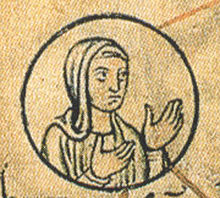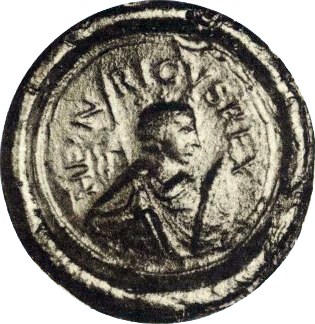
Henry the Fowler was the duke of Saxony from 912 and the king of East Francia from 919 until his death in 936. As the first non-Frankish king of East Francia, he established the Ottonian dynasty of kings and emperors, and he is generally considered to be the founder of the medieval German state, known until then as East Francia. An avid hunter, he obtained the epithet "the Fowler" because he was allegedly fixing his birding nets when messengers arrived to inform him that he was to be king.

Hugh Capet was the King of the Franks from 987 to 996. He is the founder of and first king from the House of Capet. The son of the powerful duke Hugh the Great and his wife Hedwige of Saxony, he was elected as the successor of the last Carolingian king, Louis V. Hugh was descended from Charlemagne's son Pepin of Italy through his mother and paternal grandmother, respectively, and was also a nephew of Otto the Great.
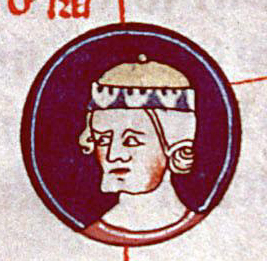
Hugh the Great was the duke of the Franks and count of Paris. He was the most powerful magnate in France.

Lotharingia was a medieval successor kingdom of the Carolingian Empire. It comprised present-day Lorraine (France), Luxembourg, Saarland (Germany), Netherlands, most of Belgium, and Germany west of the Rhine. It was named after King Lothair II, who received this territory as his share of the Kingdom of Middle Francia which his father, Lothair I, had held.

Louis V, also known as Louis the Do-Nothing, was a king of West Francia from 979 to his early death in 987. During his reign, the nobility essentially ruled the country. Dying childless, Louis V was the last Carolingian monarch in West Francia.
Otto of Burgundy was Duke of Burgundy from 956 to his death.
Henry I, called the Great, was Duke of Burgundy from 965 to his death and Count of Nevers through his first marriage. He is sometimes known as Odo-Henry or Otto-Henry, since his birth name was "Odo" and he only adopted "Henry" on being elected duke of Burgundy.

Lothair, sometimes called Lothair II, III or IV, was the penultimate Carolingian king of West Francia, reigning from 10 September 954 until his death in 986.

Richard I, also known as Richard the Fearless, was the count of Rouen from 942 to 996. Dudo of Saint-Quentin, whom Richard commissioned to write the "De moribus et actis primorum Normanniae ducum", called him a dux. However, this use of the word may have been in the context of Richard's renowned leadership in war, and not as a reference to a title of nobility. Richard either introduced feudalism into Normandy or he greatly expanded it. By the end of his reign, the most important Norman landholders held their lands in feudal tenure.

Charles was the duke of Lower Lorraine from 977 until his death.
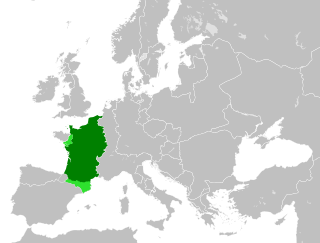
In medieval historiography, West Francia or the Kingdom of the West Franks constitutes the initial stage of the Kingdom of France and extends from the year 843, from the Treaty of Verdun, to 987, the beginning of the Capetian dynasty. It was created from the division of the Carolingian Empire following the death of Louis the Pious, with its neighbor East Francia eventually evolving into the Kingdom of Germany.
The title Duke(and Prince)of the Franks (Latin: dux(et princeps)Francorum) has been used for three different offices, always with "duke" implying military command and "prince" implying something approaching sovereign or regalian rights. The term "Franks" may refer to an ethnic group or to the inhabitants of a territory called Francia.
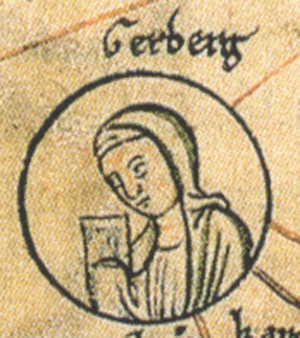
Gerberga of Saxony was the queen of France by marriage to Louis IV of France between 939 and 954. She ruled as regent during the minority of their son Lothair in 954–959.
Theobald I, called the Trickster, was Count of Blois, Tours, Chartres and Châteaudun, as well as Lord of Vierzon and Provins. He was a loyal and potent vassal of Hugh the Great, duke of the Franks.
Emma of Italy was Queen of Western Francia as the wife of King Lothair, whom she married in 965. Their son, Louis V, was the last Carolingian king.
The Robertians are the proposed Frankish family which was ancestral to the Capetian dynasty, and thus to the royal families of France and of many other countries. The Capetians appear first in the records as powerful nobles serving under the Carolingian dynasty of Charlemagne in West Francia, which later became France. As their power increased, they came into conflict with the older royal family and attained the crown several times before the eventual start of the continuous rule of the descendants of Hugh Capet.

Otto I, known as Otto the Great or Otto of Saxony, was East Frankish (German) king from 936 and Holy Roman Emperor from 962 until his death in 973. He was the eldest son of Henry the Fowler and Matilda of Ringelheim.

Matilda of France, a member of the Carolingian dynasty, was Queen of Burgundy from about 964 until her death, by her marriage with King Conrad I.

Louis IV, called d'Outremer or Transmarinus, reigned as King of West Francia from 936 to 954. A member of the Carolingian dynasty, he was the only son of king Charles the Simple and his second wife Eadgifu of Wessex, daughter of King Edward the Elder of Wessex. His reign is mostly known thanks to the Annals of Flodoard and the later Historiae of Richerus.
